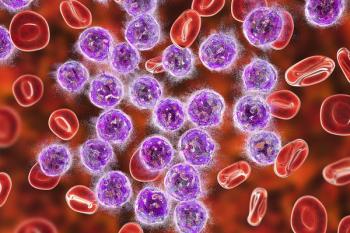
Addition of Lenalidomide to R-CHOP May Improve Outcomes in Patients With Non-GCB DLBCL
CHICAGO-Addition of the immunomodulatory agent lenalidomide to R-CHOP (rituximab, cyclophosphamide, vincristine, doxorubicin, and prednisone) may reduce the negative prognostic significance of the non-GCB (germinal center B-cell) phenotype in patients with newly diagnosed diffuse large B-cell lymphoma (DLBCL), according to findings of a phase II study (
“Despite advances in the treatment of DLBCL, approximately 40% of patients will relapse after treatment with R-CHOP,” said Nowakowski, “and unfortunately the majority of patients who relapse-particularly with early relapse-will die from the disease.” This suggests that salvage therapy has “little impact in terms of affecting outcomes” and that “better upfront therapy is needed.”
Lenalidomide plus R-CHOP was evaluated in a newly diagnosed patient population with no upper age limit, a design intended to reflect clinical practice. Median age of the 64 enrolled patients was 65 years (range, 22-87); 25% of patients were older than age 70. Sixty percent of patients had stage 4 disease and 52% had a high-intermediate or high International Prognostic Index.
Treatment consisted of lenalidomide 25 mg daily on days 1-10 of a 21-day cycle, in addition to a standard R-CHOP regimen administered every 3 cycles. Patients also received granulocyte colony-stimulating factor (GCSF) support and aspirin.
Among 55 evaluable patients with newly diagnosed non-GCB (n = 22) or GCB (n = 33) DLBCL, lenalidomide plus R-CHOP was associated with similar outcomes, with 2-year progression-free survival (PFS) rates of 60% and 59%, respectively, and 2-year overall survival (OS) rates of 83% and 75%, respectively.
Although the study was not designed to compare lenalidomide plus R-CHOP to R-CHOP, Nowakowski noted that a case-matched historical analysis revealed that outcomes with R-CHOP without the addition of lenalidomide were substantially worse among patients with non-GCB than in those with GCB DLBCL, as measured by 2-year PFS rate (28% vs 64%) and 2-year OS rate (46% vs 74%).
The addition of lenalidomide to R-CHOP was well tolerated, including in elderly patients, said Nowakowski. The most frequent grade 3/4 toxicities were neutropenia (87%), thrombocytopenia (44%), and anemia (15%). Febrile neutropenia and bleeding were rare, occurring in 9% and 1.6% of patients, respectively. One death from sepsis was reported in a patient with known bowel involvement.
These findings suggest that the addition of lenalidomide to R-CHOP “appears to be promising when compared to R-CHOP and may ameliorate the negative effect on outcomes” associated with the non-GCB phenotype.
Discussant Andre Goy, MD, chair of the John Theurer Cancer Center, Hackensack University Medical Center, Hackensack, NJ, called the results “quite striking,” although he said larger clinical studies are needed to validate the findings. He noted that prior strategies to enhance the efficacy of R-CHOP, including alternative dosing, PET-guided response, and better stratification, failed to yield substantial benefit in a large group of patients. The Eastern Cooperative Oncology Group is currently conducting a randomized study (
Lenalidomide, an analogue of thalidomide, is marketed by Celgene under the brand name Revlimid, and is currently indicated for treatment of some patients with multiple myeloma, mantle cell lymphoma, and transfusion-dependent myelodysplastic syndrome.
Newsletter
Stay up to date on recent advances in the multidisciplinary approach to cancer.
































































































